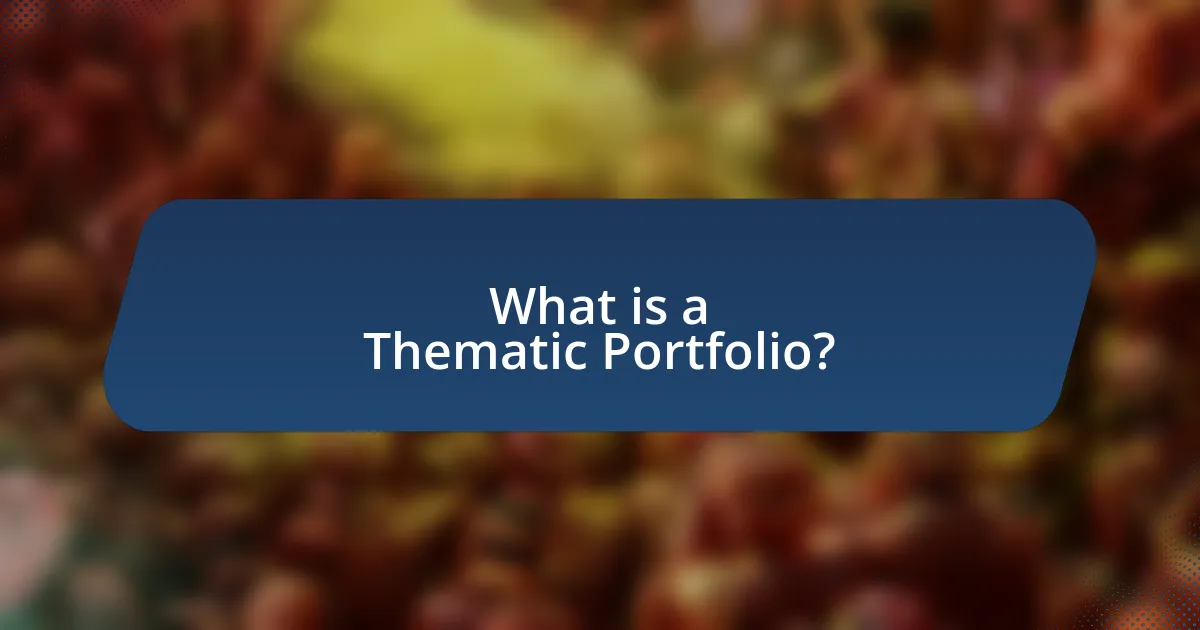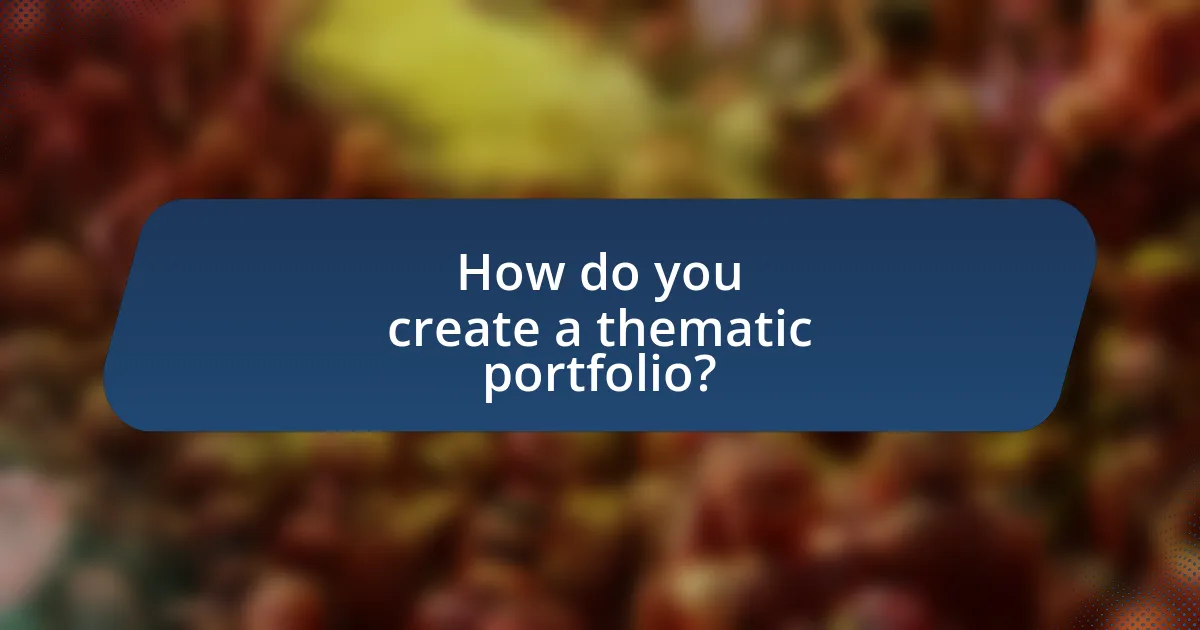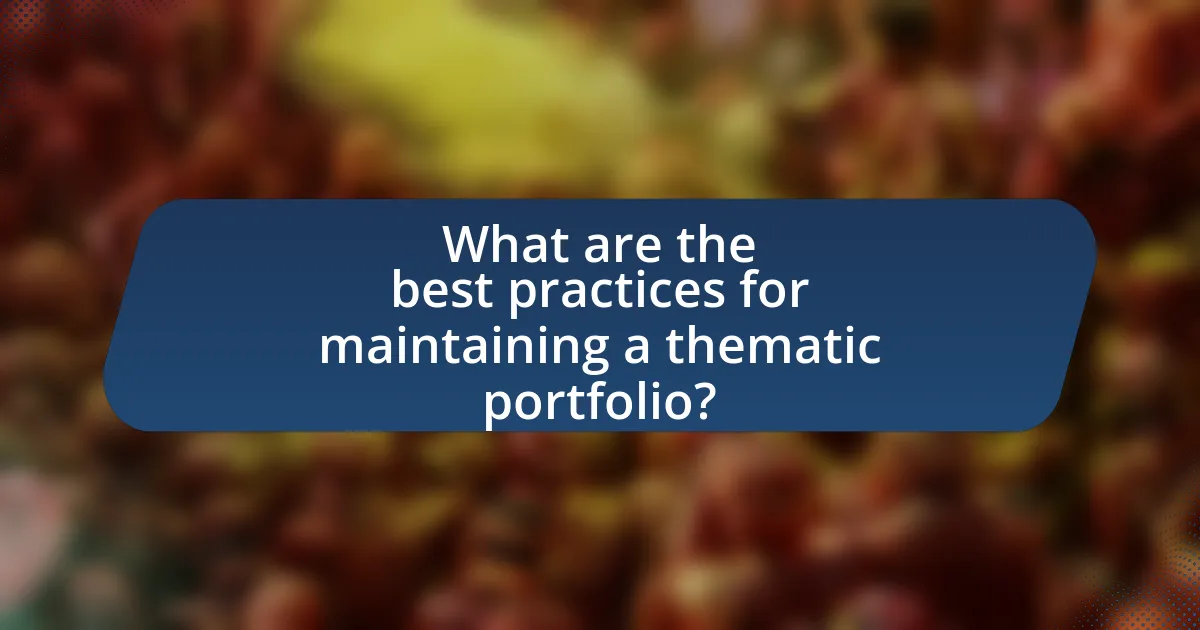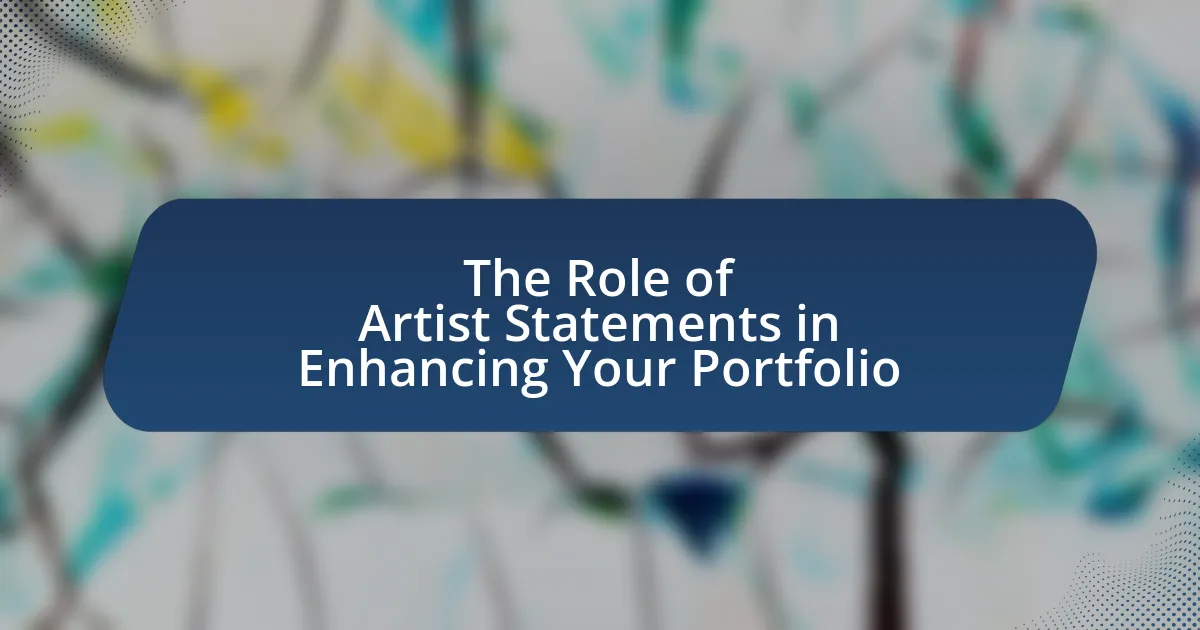A thematic portfolio is a curated collection of artworks unified by a central theme, allowing artists to showcase their exploration of specific ideas or subjects. This article outlines the differences between thematic and traditional portfolios, emphasizing the importance of a cohesive theme, curated selection, and clear presentation. Key elements for creating an effective thematic portfolio include selecting a relevant theme, conducting research, and maintaining consistency in style. The article also discusses the benefits of a thematic approach, popular themes in contemporary art, and best practices for maintaining and updating a thematic portfolio to enhance audience engagement and artistic expression.

What is a Thematic Portfolio?
A thematic portfolio is a collection of works that are unified by a central theme or concept, showcasing an artist’s exploration of a specific idea or subject matter. This type of portfolio allows artists to present their creative vision cohesively, demonstrating their ability to engage with a particular theme through various mediums or styles. For instance, an artist may create a thematic portfolio centered around environmental issues, featuring paintings, photographs, and sculptures that reflect their perspective on sustainability. Thematic portfolios are often used in applications for exhibitions, grants, or educational programs, as they effectively communicate an artist’s intent and depth of understanding regarding the chosen theme.
How does a thematic portfolio differ from a traditional portfolio?
A thematic portfolio focuses on a specific theme or concept, while a traditional portfolio showcases a broader range of work without a unifying theme. Thematic portfolios are curated to convey a particular message or artistic vision, often highlighting the artist’s exploration of a specific subject, such as nature or identity. In contrast, traditional portfolios typically include diverse pieces that demonstrate an artist’s overall skill set and versatility across various styles and mediums. This distinction allows thematic portfolios to create a more cohesive narrative, making it easier for viewers to understand the artist’s intent and perspective.
What are the key elements of a thematic portfolio?
The key elements of a thematic portfolio include a cohesive theme, a curated selection of works, clear presentation, and an artist statement. A cohesive theme ties together the artworks, ensuring they reflect a unified concept or message, which enhances the viewer’s understanding. The curated selection of works should showcase the artist’s best pieces that align with the theme, demonstrating skill and creativity. Clear presentation involves organizing the portfolio in a visually appealing manner, using consistent formatting and high-quality images to engage the audience. An artist statement provides context, explaining the theme and the artist’s intent, which helps to deepen the viewer’s connection to the work. These elements collectively create a strong thematic portfolio that effectively communicates the artist’s vision.
Why is a thematic approach beneficial for artists?
A thematic approach is beneficial for artists because it provides a cohesive framework that enhances the clarity and impact of their work. By focusing on a specific theme, artists can create a unified body of work that communicates a clear message or explores a particular concept, making it easier for audiences to engage with and understand their art. Research indicates that thematic portfolios can lead to stronger emotional connections with viewers, as they often evoke shared experiences or provoke thought on relevant issues. This approach also allows artists to showcase their versatility within a defined context, demonstrating their ability to explore different facets of a theme while maintaining a consistent artistic voice.
What themes can artists explore in their portfolios?
Artists can explore a variety of themes in their portfolios, including identity, nature, social issues, and abstraction. Each theme allows artists to convey specific messages or emotions, enhancing the viewer’s experience. For instance, the theme of identity can encompass personal narratives and cultural backgrounds, while nature can reflect environmental concerns or beauty. Social issues may address topics like inequality or justice, and abstraction can focus on form and color without representational constraints. These themes not only showcase an artist’s versatility but also engage audiences on multiple levels, making the portfolio a powerful tool for communication and expression.
How can personal experiences shape thematic choices?
Personal experiences significantly shape thematic choices by providing unique perspectives and emotional depth to artistic expression. Artists often draw from their own life events, relationships, and cultural backgrounds, which inform the themes they explore in their work. For instance, an artist who has experienced loss may create pieces that reflect themes of grief and resilience, while someone with a rich cultural heritage might incorporate elements that celebrate their identity. This connection between personal experience and thematic choice is supported by studies indicating that artists who engage with their own narratives tend to produce more authentic and relatable work, enhancing audience connection and engagement.
What are some popular themes in contemporary art?
Popular themes in contemporary art include identity, social justice, technology, and environmental issues. Artists often explore identity through personal narratives and cultural backgrounds, reflecting the diverse experiences of individuals in society. Social justice themes address inequality and activism, with works that challenge societal norms and provoke dialogue. Technology is frequently examined, highlighting its impact on human interaction and perception. Environmental issues are increasingly prominent, as artists respond to climate change and ecological concerns through their work. These themes are evident in exhibitions and collections worldwide, showcasing the relevance and urgency of contemporary artistic expression.

How do you create a thematic portfolio?
To create a thematic portfolio, an artist should first select a central theme that reflects their artistic vision or message. This theme can be based on personal experiences, social issues, or specific concepts that resonate with the artist. Once the theme is established, the artist should curate a collection of works that cohesively represent this theme, ensuring that each piece contributes to the overall narrative or concept. For instance, if the theme is “urban life,” the portfolio might include paintings, photographs, or mixed media that explore various aspects of city living.
Additionally, the artist should consider the presentation of the portfolio, including the order of the works and any accompanying text that explains the theme and the artist’s intent. This structured approach not only showcases the artist’s skills but also engages the viewer by providing a clear context for the works displayed.
What steps should artists follow to develop their thematic portfolio?
Artists should follow a structured approach to develop their thematic portfolio, which includes identifying a central theme, researching that theme, creating a cohesive body of work, and refining the presentation. First, artists must select a specific theme that resonates with their artistic vision, as this will guide their creative process. Next, thorough research on the chosen theme helps in understanding its context and significance, allowing artists to create informed and relevant artwork. After that, artists should produce a series of works that reflect the theme consistently, ensuring that each piece contributes to the overall narrative. Finally, artists need to focus on the presentation of their portfolio, which includes organizing the works in a visually appealing manner and providing context through artist statements or descriptions. This structured approach ensures that the portfolio effectively communicates the artist’s thematic exploration and artistic intent.
How do you select a cohesive theme for your portfolio?
To select a cohesive theme for your portfolio, identify a central concept that reflects your artistic vision and style. This involves analyzing your body of work to find common elements such as color schemes, subject matter, or techniques that resonate throughout your pieces. For instance, if your artwork predominantly features nature, you can create a theme centered around environmental themes, which not only unifies your portfolio but also communicates a clear message to your audience. Cohesion can be further enhanced by maintaining consistency in presentation, such as using similar framing or layout styles.
What role does research play in creating a thematic portfolio?
Research is essential in creating a thematic portfolio as it informs the artist’s choices and direction. By conducting thorough research, artists can identify trends, themes, and concepts that resonate with their target audience, ensuring that their work is relevant and engaging. For instance, analyzing successful portfolios in similar genres can provide insights into effective presentation and thematic coherence. Additionally, research into historical context, cultural significance, and current market demands allows artists to create a portfolio that not only showcases their skills but also tells a compelling story aligned with contemporary artistic dialogues.
How can artists effectively showcase their work within a theme?
Artists can effectively showcase their work within a theme by curating a cohesive collection that reflects a specific concept or narrative. This involves selecting pieces that share common elements such as color palette, subject matter, or style, which helps to create a unified visual experience. For instance, a study by the National Endowment for the Arts highlights that thematic exhibitions can enhance viewer engagement by providing context and deeper understanding of the artwork. Additionally, artists should consider the arrangement and presentation of their work, ensuring that each piece complements the others and reinforces the overall theme.
What strategies can be used to present artwork cohesively?
To present artwork cohesively, artists should employ strategies such as establishing a clear theme, maintaining consistent visual elements, and creating a narrative flow. A clear theme unifies the artwork, making it easier for viewers to understand the artist’s intent and message. Consistent visual elements, such as color palettes, styles, and techniques, enhance the overall aesthetic and create a harmonious presentation. Additionally, a narrative flow guides viewers through the artwork, allowing them to engage with the pieces in a meaningful way. These strategies are supported by research indicating that thematic coherence significantly enhances viewer engagement and comprehension in art presentations.
How can storytelling enhance the presentation of a thematic portfolio?
Storytelling enhances the presentation of a thematic portfolio by creating a cohesive narrative that connects individual pieces, making the overall message more engaging and memorable. This narrative framework allows viewers to understand the artist’s intent and emotional journey, fostering a deeper connection with the work. Research indicates that narratives can significantly improve information retention; for instance, a study published in the journal “Cognitive Science” found that stories are up to 22 times more memorable than facts alone. By integrating storytelling, artists can effectively communicate their themes and concepts, leading to a more impactful presentation.

What are the best practices for maintaining a thematic portfolio?
The best practices for maintaining a thematic portfolio include regularly updating the portfolio with new works that align with the chosen theme, ensuring consistency in style and presentation, and periodically reviewing the portfolio to remove outdated or less relevant pieces. Regular updates keep the portfolio fresh and relevant, while consistency in style enhances the thematic coherence, making it easier for viewers to understand the artist’s vision. Periodic reviews allow artists to assess the effectiveness of their theme and make necessary adjustments, ensuring that the portfolio remains a true reflection of their artistic journey and goals.
How often should artists update their thematic portfolios?
Artists should update their thematic portfolios at least once a year to reflect their evolving style and new works. Regular updates ensure that the portfolio remains relevant and showcases the artist’s latest skills and themes, which is crucial for attracting potential clients and galleries. According to a survey by the National Endowment for the Arts, artists who frequently refresh their portfolios are more likely to secure exhibitions and sales, highlighting the importance of maintaining an up-to-date representation of their work.
What should artists consider when adding new works to their portfolio?
Artists should consider the cohesiveness and thematic relevance of new works when adding them to their portfolio. A well-curated portfolio should reflect a consistent style, message, or concept that resonates with the artist’s overall vision. For instance, research indicates that portfolios showcasing a clear theme are more appealing to galleries and collectors, as they demonstrate the artist’s ability to explore and develop ideas deeply. Additionally, artists should evaluate how new pieces complement existing works, ensuring that they enhance rather than detract from the overall narrative of the portfolio.
How can feedback influence the evolution of a thematic portfolio?
Feedback can significantly influence the evolution of a thematic portfolio by providing artists with insights into audience perceptions and preferences. This external input allows artists to refine their thematic focus, enhance their artistic techniques, and adjust their presentation strategies. For instance, constructive criticism can highlight strengths and weaknesses in an artist’s work, guiding them to emphasize successful themes or explore new directions. Research indicates that artists who actively seek and incorporate feedback often experience greater growth and innovation in their portfolios, as evidenced by studies showing that iterative feedback loops lead to improved creative outcomes.
What common mistakes should artists avoid when creating a thematic portfolio?
Artists should avoid inconsistency in style and theme when creating a thematic portfolio. A cohesive portfolio demonstrates a clear artistic vision and helps viewers understand the artist’s intent. Additionally, artists should refrain from including unrelated works, as this can dilute the thematic focus and confuse the audience. Another common mistake is neglecting to curate the selection of pieces; including too many works can overwhelm viewers and detract from the strongest pieces. Lastly, artists should avoid poor presentation, as a lack of professionalism in displaying their work can undermine the perceived quality of the portfolio.
How can overcomplicating themes detract from the portfolio’s impact?
Overcomplicating themes can detract from a portfolio’s impact by obscuring the core message and making it difficult for viewers to engage with the work. When themes are overly intricate, they can confuse the audience, leading to a lack of clarity and emotional connection. Research indicates that simplicity in design and messaging enhances viewer comprehension and retention; for instance, studies show that audiences are more likely to remember and appreciate artwork that conveys a clear, straightforward theme. Therefore, maintaining thematic clarity is essential for maximizing the effectiveness of an artistic portfolio.
What are the pitfalls of neglecting audience engagement?
Neglecting audience engagement leads to decreased visibility and relevance in the art community. When artists fail to connect with their audience, they risk losing potential supporters and customers, which can result in diminished sales and opportunities for collaboration. According to a study by the National Endowment for the Arts, artists who actively engage with their audience report higher levels of satisfaction and success in their careers. Furthermore, without audience feedback, artists may miss valuable insights that could enhance their work and thematic portfolio, ultimately stunting their growth and innovation in the field.
What practical tips can help artists create an effective thematic portfolio?
To create an effective thematic portfolio, artists should focus on a cohesive theme that reflects their unique style and vision. This involves selecting a specific concept or narrative that ties the artwork together, ensuring that each piece contributes to the overall message. For instance, an artist might choose to explore themes of nature, identity, or social issues, which can guide their selection of works and presentation style. Additionally, artists should curate their portfolio by including only their strongest pieces that best represent the chosen theme, as quality over quantity is crucial in making a lasting impression. Research indicates that a well-defined theme can enhance the viewer’s understanding and emotional connection to the artwork, making it more impactful.





